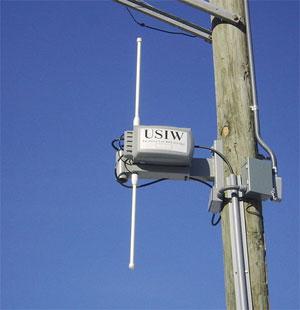 If driving while texting is risky, how much worse is browsing?[/caption] It must have seemed like a good idea to put WiFi access points in cars, transforming each one into a rolling hotspot as well as a raging nexus of driver inattention and Technology Induced Attention Deficit Disorder. Most 2014 car models from GM, and a dangerously high number of models from other companies, will come with some level of broadband wireless Internet access available – many with full 4G LTE, according to NBCNews and GM. Having WiFi connections everywhere may be critically important to making the Internet of Things work and pumping up the ROI on a company's high-maintenance BYOD program. But if thousands can be killed or injured paying attention to a phone with comparatively lame connections, how bad will the carnage be after manufacturers add technology so sticky that many users can't take their eyes off the screen even during conversations with actual people within their physical space? Is that a technology that should be introduced into the most dangerous environment most people ever enter? If it were dangerous, would it attract a long list of leading vendors including Broadcom, Comcast, Cisco, Rogers Communications, Sprint, the FCC, the U.S. Dept. of Transportation, Audi, T-Mobile, Chrysler, GM, BMW, AT&T and who knows how many other IT and service providers? Shockingly, as it turns out, having high-speed Internet access in the car can be dangerously distracting even if the devices connected to it are all voice-enabled rather than requiring drivers to take their hands off the wheel to type and squint at tiny screens. "Many people assume that talking to a voice-operated device will be as safe as using a hands-free cell phone, but neither activity is safe," according to Ian Spence, a professor of psychology at the University of Toronto, whose paper "How Speech Modifies Visual Attention" was published in the Sept./Oct. issue of Applied Cognitive Psychology. Spence and a team of researchers tested the ability of volunteers to pay attention to a visual task and perform it correctly in the presence of other potential distractions such as listening to a car radio, answering simple yes/no questions from a researcher, or playing word games. Subjects responded more slowly to the visual task no matter what the distraction was, and responded much more slowly as the complexity of the distraction rose. Listening to the radio didn't slow responses nearly as much as word games or other distractions that required actual thought from the user – the kind of thought needed to type or speak URLs, or search terms to a WiFi connected in-car device, for example. Even refusing to respond verbally didn't distract test subjects any less or improve their performance on visual tests. "It did not matter whether the subject spoke the answer aloud or simply thought about the answer," Spence said in an announcement about the research. "It was the thinking, not speaking, that caused them to slow down." Luckily, it won't be long before self-driving cars arrive to solve all those potentially fatal Internet-and-roadway interactions. A survey from KPMG, in fact, shows that consumers, asked from whom they would be comfortable buying a self-driving car, are more confident in tech vendors such as Apple than carmakers like Audi or Mercedes.
If driving while texting is risky, how much worse is browsing?[/caption] It must have seemed like a good idea to put WiFi access points in cars, transforming each one into a rolling hotspot as well as a raging nexus of driver inattention and Technology Induced Attention Deficit Disorder. Most 2014 car models from GM, and a dangerously high number of models from other companies, will come with some level of broadband wireless Internet access available – many with full 4G LTE, according to NBCNews and GM. Having WiFi connections everywhere may be critically important to making the Internet of Things work and pumping up the ROI on a company's high-maintenance BYOD program. But if thousands can be killed or injured paying attention to a phone with comparatively lame connections, how bad will the carnage be after manufacturers add technology so sticky that many users can't take their eyes off the screen even during conversations with actual people within their physical space? Is that a technology that should be introduced into the most dangerous environment most people ever enter? If it were dangerous, would it attract a long list of leading vendors including Broadcom, Comcast, Cisco, Rogers Communications, Sprint, the FCC, the U.S. Dept. of Transportation, Audi, T-Mobile, Chrysler, GM, BMW, AT&T and who knows how many other IT and service providers? Shockingly, as it turns out, having high-speed Internet access in the car can be dangerously distracting even if the devices connected to it are all voice-enabled rather than requiring drivers to take their hands off the wheel to type and squint at tiny screens. "Many people assume that talking to a voice-operated device will be as safe as using a hands-free cell phone, but neither activity is safe," according to Ian Spence, a professor of psychology at the University of Toronto, whose paper "How Speech Modifies Visual Attention" was published in the Sept./Oct. issue of Applied Cognitive Psychology. Spence and a team of researchers tested the ability of volunteers to pay attention to a visual task and perform it correctly in the presence of other potential distractions such as listening to a car radio, answering simple yes/no questions from a researcher, or playing word games. Subjects responded more slowly to the visual task no matter what the distraction was, and responded much more slowly as the complexity of the distraction rose. Listening to the radio didn't slow responses nearly as much as word games or other distractions that required actual thought from the user – the kind of thought needed to type or speak URLs, or search terms to a WiFi connected in-car device, for example. Even refusing to respond verbally didn't distract test subjects any less or improve their performance on visual tests. "It did not matter whether the subject spoke the answer aloud or simply thought about the answer," Spence said in an announcement about the research. "It was the thinking, not speaking, that caused them to slow down." Luckily, it won't be long before self-driving cars arrive to solve all those potentially fatal Internet-and-roadway interactions. A survey from KPMG, in fact, shows that consumers, asked from whom they would be comfortable buying a self-driving car, are more confident in tech vendors such as Apple than carmakers like Audi or Mercedes.
Worst Idea a Whole Industry Ever Had: WiFi in The Car
[caption id="attachment_13205" align="aligncenter" width="500"] If driving while texting is risky, how much worse is browsing?[/caption] It must have seemed like a good idea to put WiFi access points in cars, transforming each one into a rolling hotspot as well as a raging nexus of driver inattention and Technology Induced Attention Deficit Disorder. Most 2014 car models from GM, and a dangerously high number of models from other companies, will come with some level of broadband wireless Internet access available – many with full 4G LTE, according to NBCNews and GM. Having WiFi connections everywhere may be critically important to making the Internet of Things work and pumping up the ROI on a company's high-maintenance BYOD program. But if thousands can be killed or injured paying attention to a phone with comparatively lame connections, how bad will the carnage be after manufacturers add technology so sticky that many users can't take their eyes off the screen even during conversations with actual people within their physical space? Is that a technology that should be introduced into the most dangerous environment most people ever enter? If it were dangerous, would it attract a long list of leading vendors including Broadcom, Comcast, Cisco, Rogers Communications, Sprint, the FCC, the U.S. Dept. of Transportation, Audi, T-Mobile, Chrysler, GM, BMW, AT&T and who knows how many other IT and service providers? Shockingly, as it turns out, having high-speed Internet access in the car can be dangerously distracting even if the devices connected to it are all voice-enabled rather than requiring drivers to take their hands off the wheel to type and squint at tiny screens. "Many people assume that talking to a voice-operated device will be as safe as using a hands-free cell phone, but neither activity is safe," according to Ian Spence, a professor of psychology at the University of Toronto, whose paper "How Speech Modifies Visual Attention" was published in the Sept./Oct. issue of Applied Cognitive Psychology. Spence and a team of researchers tested the ability of volunteers to pay attention to a visual task and perform it correctly in the presence of other potential distractions such as listening to a car radio, answering simple yes/no questions from a researcher, or playing word games. Subjects responded more slowly to the visual task no matter what the distraction was, and responded much more slowly as the complexity of the distraction rose. Listening to the radio didn't slow responses nearly as much as word games or other distractions that required actual thought from the user – the kind of thought needed to type or speak URLs, or search terms to a WiFi connected in-car device, for example. Even refusing to respond verbally didn't distract test subjects any less or improve their performance on visual tests. "It did not matter whether the subject spoke the answer aloud or simply thought about the answer," Spence said in an announcement about the research. "It was the thinking, not speaking, that caused them to slow down." Luckily, it won't be long before self-driving cars arrive to solve all those potentially fatal Internet-and-roadway interactions. A survey from KPMG, in fact, shows that consumers, asked from whom they would be comfortable buying a self-driving car, are more confident in tech vendors such as Apple than carmakers like Audi or Mercedes.
If driving while texting is risky, how much worse is browsing?[/caption] It must have seemed like a good idea to put WiFi access points in cars, transforming each one into a rolling hotspot as well as a raging nexus of driver inattention and Technology Induced Attention Deficit Disorder. Most 2014 car models from GM, and a dangerously high number of models from other companies, will come with some level of broadband wireless Internet access available – many with full 4G LTE, according to NBCNews and GM. Having WiFi connections everywhere may be critically important to making the Internet of Things work and pumping up the ROI on a company's high-maintenance BYOD program. But if thousands can be killed or injured paying attention to a phone with comparatively lame connections, how bad will the carnage be after manufacturers add technology so sticky that many users can't take their eyes off the screen even during conversations with actual people within their physical space? Is that a technology that should be introduced into the most dangerous environment most people ever enter? If it were dangerous, would it attract a long list of leading vendors including Broadcom, Comcast, Cisco, Rogers Communications, Sprint, the FCC, the U.S. Dept. of Transportation, Audi, T-Mobile, Chrysler, GM, BMW, AT&T and who knows how many other IT and service providers? Shockingly, as it turns out, having high-speed Internet access in the car can be dangerously distracting even if the devices connected to it are all voice-enabled rather than requiring drivers to take their hands off the wheel to type and squint at tiny screens. "Many people assume that talking to a voice-operated device will be as safe as using a hands-free cell phone, but neither activity is safe," according to Ian Spence, a professor of psychology at the University of Toronto, whose paper "How Speech Modifies Visual Attention" was published in the Sept./Oct. issue of Applied Cognitive Psychology. Spence and a team of researchers tested the ability of volunteers to pay attention to a visual task and perform it correctly in the presence of other potential distractions such as listening to a car radio, answering simple yes/no questions from a researcher, or playing word games. Subjects responded more slowly to the visual task no matter what the distraction was, and responded much more slowly as the complexity of the distraction rose. Listening to the radio didn't slow responses nearly as much as word games or other distractions that required actual thought from the user – the kind of thought needed to type or speak URLs, or search terms to a WiFi connected in-car device, for example. Even refusing to respond verbally didn't distract test subjects any less or improve their performance on visual tests. "It did not matter whether the subject spoke the answer aloud or simply thought about the answer," Spence said in an announcement about the research. "It was the thinking, not speaking, that caused them to slow down." Luckily, it won't be long before self-driving cars arrive to solve all those potentially fatal Internet-and-roadway interactions. A survey from KPMG, in fact, shows that consumers, asked from whom they would be comfortable buying a self-driving car, are more confident in tech vendors such as Apple than carmakers like Audi or Mercedes.
 If driving while texting is risky, how much worse is browsing?[/caption] It must have seemed like a good idea to put WiFi access points in cars, transforming each one into a rolling hotspot as well as a raging nexus of driver inattention and Technology Induced Attention Deficit Disorder. Most 2014 car models from GM, and a dangerously high number of models from other companies, will come with some level of broadband wireless Internet access available – many with full 4G LTE, according to NBCNews and GM. Having WiFi connections everywhere may be critically important to making the Internet of Things work and pumping up the ROI on a company's high-maintenance BYOD program. But if thousands can be killed or injured paying attention to a phone with comparatively lame connections, how bad will the carnage be after manufacturers add technology so sticky that many users can't take their eyes off the screen even during conversations with actual people within their physical space? Is that a technology that should be introduced into the most dangerous environment most people ever enter? If it were dangerous, would it attract a long list of leading vendors including Broadcom, Comcast, Cisco, Rogers Communications, Sprint, the FCC, the U.S. Dept. of Transportation, Audi, T-Mobile, Chrysler, GM, BMW, AT&T and who knows how many other IT and service providers? Shockingly, as it turns out, having high-speed Internet access in the car can be dangerously distracting even if the devices connected to it are all voice-enabled rather than requiring drivers to take their hands off the wheel to type and squint at tiny screens. "Many people assume that talking to a voice-operated device will be as safe as using a hands-free cell phone, but neither activity is safe," according to Ian Spence, a professor of psychology at the University of Toronto, whose paper "How Speech Modifies Visual Attention" was published in the Sept./Oct. issue of Applied Cognitive Psychology. Spence and a team of researchers tested the ability of volunteers to pay attention to a visual task and perform it correctly in the presence of other potential distractions such as listening to a car radio, answering simple yes/no questions from a researcher, or playing word games. Subjects responded more slowly to the visual task no matter what the distraction was, and responded much more slowly as the complexity of the distraction rose. Listening to the radio didn't slow responses nearly as much as word games or other distractions that required actual thought from the user – the kind of thought needed to type or speak URLs, or search terms to a WiFi connected in-car device, for example. Even refusing to respond verbally didn't distract test subjects any less or improve their performance on visual tests. "It did not matter whether the subject spoke the answer aloud or simply thought about the answer," Spence said in an announcement about the research. "It was the thinking, not speaking, that caused them to slow down." Luckily, it won't be long before self-driving cars arrive to solve all those potentially fatal Internet-and-roadway interactions. A survey from KPMG, in fact, shows that consumers, asked from whom they would be comfortable buying a self-driving car, are more confident in tech vendors such as Apple than carmakers like Audi or Mercedes.
If driving while texting is risky, how much worse is browsing?[/caption] It must have seemed like a good idea to put WiFi access points in cars, transforming each one into a rolling hotspot as well as a raging nexus of driver inattention and Technology Induced Attention Deficit Disorder. Most 2014 car models from GM, and a dangerously high number of models from other companies, will come with some level of broadband wireless Internet access available – many with full 4G LTE, according to NBCNews and GM. Having WiFi connections everywhere may be critically important to making the Internet of Things work and pumping up the ROI on a company's high-maintenance BYOD program. But if thousands can be killed or injured paying attention to a phone with comparatively lame connections, how bad will the carnage be after manufacturers add technology so sticky that many users can't take their eyes off the screen even during conversations with actual people within their physical space? Is that a technology that should be introduced into the most dangerous environment most people ever enter? If it were dangerous, would it attract a long list of leading vendors including Broadcom, Comcast, Cisco, Rogers Communications, Sprint, the FCC, the U.S. Dept. of Transportation, Audi, T-Mobile, Chrysler, GM, BMW, AT&T and who knows how many other IT and service providers? Shockingly, as it turns out, having high-speed Internet access in the car can be dangerously distracting even if the devices connected to it are all voice-enabled rather than requiring drivers to take their hands off the wheel to type and squint at tiny screens. "Many people assume that talking to a voice-operated device will be as safe as using a hands-free cell phone, but neither activity is safe," according to Ian Spence, a professor of psychology at the University of Toronto, whose paper "How Speech Modifies Visual Attention" was published in the Sept./Oct. issue of Applied Cognitive Psychology. Spence and a team of researchers tested the ability of volunteers to pay attention to a visual task and perform it correctly in the presence of other potential distractions such as listening to a car radio, answering simple yes/no questions from a researcher, or playing word games. Subjects responded more slowly to the visual task no matter what the distraction was, and responded much more slowly as the complexity of the distraction rose. Listening to the radio didn't slow responses nearly as much as word games or other distractions that required actual thought from the user – the kind of thought needed to type or speak URLs, or search terms to a WiFi connected in-car device, for example. Even refusing to respond verbally didn't distract test subjects any less or improve their performance on visual tests. "It did not matter whether the subject spoke the answer aloud or simply thought about the answer," Spence said in an announcement about the research. "It was the thinking, not speaking, that caused them to slow down." Luckily, it won't be long before self-driving cars arrive to solve all those potentially fatal Internet-and-roadway interactions. A survey from KPMG, in fact, shows that consumers, asked from whom they would be comfortable buying a self-driving car, are more confident in tech vendors such as Apple than carmakers like Audi or Mercedes.



